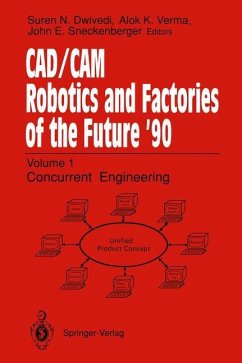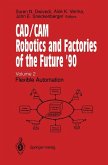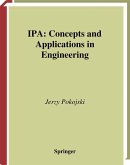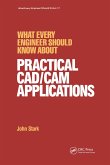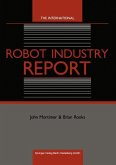CAD/CAM Robotics and Factories of the Future '90
Volume 1: Concurrent Engineering 5th International Conference on CAD/CAM, Robotics, and Factories of the Future (CARS and FOF'90 Proceedings International Society for Productivity Enhancement
Herausgegeben von Dwivedi, Suren N.; Verma, Alok K.; Sneckenberger, John E.
CAD/CAM Robotics and Factories of the Future '90
Volume 1: Concurrent Engineering 5th International Conference on CAD/CAM, Robotics, and Factories of the Future (CARS and FOF'90 Proceedings International Society for Productivity Enhancement
Herausgegeben von Dwivedi, Suren N.; Verma, Alok K.; Sneckenberger, John E.
- Broschiertes Buch
- Merkliste
- Auf die Merkliste
- Bewerten Bewerten
- Teilen
- Produkt teilen
- Produkterinnerung
- Produkterinnerung
According to the Concurrent Engineering Research Center (CERC) at West Virginia University, "the concurrent engineering (CE) is a rapid simultaneous approach where research and development, design, manufacturing and support are carried out in parallel". The mission of concurrent engineering is to reduce time to market, improve total quality and lower cost for products or systems developed and supported by large organizations. The purpose of the concurrent design methodology is to let the designer know the consequences of his design decisions in the manufacturing and assembly stages as well as…mehr
Andere Kunden interessierten sich auch für
![CAD/CAM Robotics and Factories of the Future '90 CAD/CAM Robotics and Factories of the Future '90]() CAD/CAM Robotics and Factories of the Future '9039,99 €
CAD/CAM Robotics and Factories of the Future '9039,99 €![Eco-Factories of the Future Eco-Factories of the Future]() Eco-Factories of the Future75,99 €
Eco-Factories of the Future75,99 €![Eco-Factories of the Future Eco-Factories of the Future]() Eco-Factories of the Future75,99 €
Eco-Factories of the Future75,99 €![IPA -- Concepts and Applications in Engineering IPA -- Concepts and Applications in Engineering]() Jerzy PokojskiIPA -- Concepts and Applications in Engineering106,99 €
Jerzy PokojskiIPA -- Concepts and Applications in Engineering106,99 €![What Every Engineer Should Know about Practical CAD/CAM Applications What Every Engineer Should Know about Practical CAD/CAM Applications]() John StarkWhat Every Engineer Should Know about Practical CAD/CAM Applications144,99 €
John StarkWhat Every Engineer Should Know about Practical CAD/CAM Applications144,99 €![The International Robot Industry Report The International Robot Industry Report]() John MortimerThe International Robot Industry Report77,99 €
John MortimerThe International Robot Industry Report77,99 €![Boundary Representation Modelling Techniques Boundary Representation Modelling Techniques]() Ian A. StroudBoundary Representation Modelling Techniques344,99 €
Ian A. StroudBoundary Representation Modelling Techniques344,99 €-
-
-
According to the Concurrent Engineering Research Center (CERC) at West Virginia University, "the concurrent engineering (CE) is a rapid simultaneous approach where research and development, design, manufacturing and support are carried out in parallel". The mission of concurrent engineering is to reduce time to market, improve total quality and lower cost for products or systems developed and supported by large organizations. The purpose of the concurrent design methodology is to let the designer know the consequences of his design decisions in the manufacturing and assembly stages as well as in subsequent operations. Design for manufacture and assembly, design for reliability and testability, CAD/CAM/CAE, knowledge based systems, cost analysis and advanced material technology are the major constituents of concurrent engineering. The need for concurrent engineering can be justified from the fact that in every production cycle, the design phase approximately takes 5 to 10% of the total cycle, but overall it influences 80% of the production cycle. This volume contains articles from a wide spectrum dealing with concepts of concurrent engineering. The importance of the knowledge-based systems in the CE environment is significant as they provide the common platform to achieve the same level of expertise to the designers and manufacturers throughout the organization for the specific task. Their role in "do it right the first time" is very important in providing aid to the designers and manufacturers to optimize the design and manufacturing setups for a cost effectiveness and reduced production time.
Produktdetails
- Produktdetails
- Verlag: Springer / Springer Berlin Heidelberg / Springer, Berlin
- Artikelnr. des Verlages: 978-3-642-84340-2
- Softcover reprint of the original 1st ed. 1991
- Seitenzahl: 620
- Erscheinungstermin: 27. Dezember 2011
- Englisch
- Abmessung: 235mm x 155mm x 34mm
- Gewicht: 924g
- ISBN-13: 9783642843402
- ISBN-10: 3642843409
- Artikelnr.: 36120942
- Herstellerkennzeichnung
- Springer-Verlag GmbH
- Tiergartenstr. 17
- 69121 Heidelberg
- ProductSafety@springernature.com
- Verlag: Springer / Springer Berlin Heidelberg / Springer, Berlin
- Artikelnr. des Verlages: 978-3-642-84340-2
- Softcover reprint of the original 1st ed. 1991
- Seitenzahl: 620
- Erscheinungstermin: 27. Dezember 2011
- Englisch
- Abmessung: 235mm x 155mm x 34mm
- Gewicht: 924g
- ISBN-13: 9783642843402
- ISBN-10: 3642843409
- Artikelnr.: 36120942
- Herstellerkennzeichnung
- Springer-Verlag GmbH
- Tiergartenstr. 17
- 69121 Heidelberg
- ProductSafety@springernature.com
Contents, Volume 1.- I: General Issues: Introduction.- Concurrent Engineering: An Introduction.- Quality Design Engineering: The Missing Link in U.S. Competitiveness.- New Activities in the Manufacturing Domain to Support the Concurrent Engineering Process.- II: Intelligent Information Networks: Introduction.- Artificial Intelligence in Concurrent Engineering.- An Open Ended Network Architecture for Integrated Control and Manufacturing.- A Data Base Inconsistency Checker for EASIE.- Database Exchange in the CAD/CAM/CIM Arena.- Formation of Machine Cells: A Fuzzy Set Approach.- Design Assessment Tool.- Support of PCs in Concurrent Engineering.- III: Neural Network: Introduction.- Artificial Neural Networks In Manufacturing.- Using Artificial Neural Networks For Flexible Manufacturing System Scheduling.- Machine-Part Family Formation Using Neural Networks.- Neural Networks in Process Diagnostics.- IV: Knowledge Based Engineering: Introduction.- DICEtalk: An Object-Oriented Knowledge-Based Engineering Environment.- Data Models of Mechanical Systems for Concurrent Design.- Manufacturing Knowledge Representation Using an Object Oriented Data Model.- Knowledge-Based Evaluation of Manufacturability.- Knowledge-Based Graphic User Interface Management Methodology.- Knowledge Augmentation Via Interactive Learning in a Path Finder.- Graphical User Interface with Object-Oriented Knowledge-Based Engineering Environment.- Knowledge Automation: Unifying Learning Automation and Knowledge Base.- Developing a Knowledge Based System for Progressive Die Design.- An Expert System Model for the Use in Some Aspects of Manufacturing.- V: Feature Based Design and Manufacturing: Introduction.- Using a Feature Algebra in Concurrent Engineering Design and Manufacturing.- Feature Recognition DuringDesign Evolution.- Extraction of Manufacturing Features from an I-DEAS Universal File.- Feature Based Design Assembly.- Feature Based Machining Analysis and Cost Estimation for the Manufacture of Complex Geometries in Concurrent Engineering.- Use of Part Features for Process Planning.- VI: CAD and FEM: Introduction.- Model Based 3-D Curved Object Recognition Using Quadrics.- Finite-Element Model for Modal Analysis of Pretwisted Unsymmetric Blades.- Computer Based Life Prediction Methodology for Structural Design.- VII: Process Modeling and Control: Introduction.- Processing of Superalloys in the 1990s.- Application of the Finite Element Method in Metal Forming Process Design.- Strategic Value of Concurrent Product and Process Engineering.- The Design Process for Concurrent Engineering.- Modeling Concurrent Manufacturing Systems Using Petri Nets.- Production Planning and Control in the Factory of the Future.- Expert Control of Turning Process.- Expert System for Milling Process Selection.- Forging Die Design with Artificial Intelligence.- VIII: Process Simulation and Automation: Introduction.- Simulation Modeling in CIM Systems Design.- EXSEMA-An EXpert System for SElecting Simulation Software for Manufacturing Applications.- Group Technology Analysis for Manufacturing Data.- Dispatching Mobile Robots in Flexible Manufacturing Systems: The Issues and Problems.- Automation of Prototype General Aviation Aircraft Development.- Determining Organizational Readiness for Advanced Manufacturing Technology: Development of a Knowledge-Based System to Aid Implementation.- Planning and Realization of Skill Based Flexible Automation for Developing Countries.- IX: PCB Manufacturability and Assembly: Introduction.- An Expert System Based Concurrent Engineering Approach to PCB Assembly.- Real Time Production Scheduling and Dynamic Parts Routing for Flexible Assembly Lines.- A Knowledge-Based proach for Manufacturability of Printed Wiring Boards.- Design of an IGES Post Processor and Integration with a Robotic Workcell.- Discrete Optimum Assembly Methods for Automated Workcells.- Trajectory Planning for Obstacle-Avoided Assembly of Planar Printed Circuit Boards.- Development of a Vision Assisted Optimal Part-To-Pad Placement Technique for Printed Circuit Board Assembly.- X: Quality Control Techniques: Introduction.- Quality Function Deployment, a Technique of Design for Quality.- Quality Value Function and Consumer Quality Loss.- Implementation of a Computer Aided Quality System (CAQ) in CIM Environment: Advantages and Disadvantages.- Computer Aided Quality Assurance Systems.- Quality Consideration During DFA Analysis.- Selection of Acceptance Sampling Plans Through Knowledge Based Approach.- XI: Cost Analysis Concept: Introduction.- Analysis of Quality Costs: A Critical Elem:nt in CIM.- A Databased Time and Cost Estimation Algorithm for Piece Part Design and Manufacturing.- Improvement Curves in Manufacturing.- XII: Materials: Composite: Introduction.- The Payoffs of Concurrent Engineering in Advanced Materials Development.- A Practical Engineering Approach for Predicting Interlaminar Stresses in Composites.- Interactive Optimum Parametric Design of Laminated Composite Flange.- Computer Aided Dynamic Analysis of Laminated Composite Plates.- Integration of Rigid-Plastic Simulation Engines into Engineering Database System for Advanced Forging.- XIII: Implementation: Introduction.- Transitioning CE Technology to Industry.- Integrated Models of FMS in Concurrent Engineering Environment.- Implementing QED at the Ford Motor Company.
Contents, Volume 1.- I: General Issues: Introduction.- Concurrent Engineering: An Introduction.- Quality Design Engineering: The Missing Link in U.S. Competitiveness.- New Activities in the Manufacturing Domain to Support the Concurrent Engineering Process.- II: Intelligent Information Networks: Introduction.- Artificial Intelligence in Concurrent Engineering.- An Open Ended Network Architecture for Integrated Control and Manufacturing.- A Data Base Inconsistency Checker for EASIE.- Database Exchange in the CAD/CAM/CIM Arena.- Formation of Machine Cells: A Fuzzy Set Approach.- Design Assessment Tool.- Support of PCs in Concurrent Engineering.- III: Neural Network: Introduction.- Artificial Neural Networks In Manufacturing.- Using Artificial Neural Networks For Flexible Manufacturing System Scheduling.- Machine-Part Family Formation Using Neural Networks.- Neural Networks in Process Diagnostics.- IV: Knowledge Based Engineering: Introduction.- DICEtalk: An Object-Oriented Knowledge-Based Engineering Environment.- Data Models of Mechanical Systems for Concurrent Design.- Manufacturing Knowledge Representation Using an Object Oriented Data Model.- Knowledge-Based Evaluation of Manufacturability.- Knowledge-Based Graphic User Interface Management Methodology.- Knowledge Augmentation Via Interactive Learning in a Path Finder.- Graphical User Interface with Object-Oriented Knowledge-Based Engineering Environment.- Knowledge Automation: Unifying Learning Automation and Knowledge Base.- Developing a Knowledge Based System for Progressive Die Design.- An Expert System Model for the Use in Some Aspects of Manufacturing.- V: Feature Based Design and Manufacturing: Introduction.- Using a Feature Algebra in Concurrent Engineering Design and Manufacturing.- Feature Recognition DuringDesign Evolution.- Extraction of Manufacturing Features from an I-DEAS Universal File.- Feature Based Design Assembly.- Feature Based Machining Analysis and Cost Estimation for the Manufacture of Complex Geometries in Concurrent Engineering.- Use of Part Features for Process Planning.- VI: CAD and FEM: Introduction.- Model Based 3-D Curved Object Recognition Using Quadrics.- Finite-Element Model for Modal Analysis of Pretwisted Unsymmetric Blades.- Computer Based Life Prediction Methodology for Structural Design.- VII: Process Modeling and Control: Introduction.- Processing of Superalloys in the 1990s.- Application of the Finite Element Method in Metal Forming Process Design.- Strategic Value of Concurrent Product and Process Engineering.- The Design Process for Concurrent Engineering.- Modeling Concurrent Manufacturing Systems Using Petri Nets.- Production Planning and Control in the Factory of the Future.- Expert Control of Turning Process.- Expert System for Milling Process Selection.- Forging Die Design with Artificial Intelligence.- VIII: Process Simulation and Automation: Introduction.- Simulation Modeling in CIM Systems Design.- EXSEMA-An EXpert System for SElecting Simulation Software for Manufacturing Applications.- Group Technology Analysis for Manufacturing Data.- Dispatching Mobile Robots in Flexible Manufacturing Systems: The Issues and Problems.- Automation of Prototype General Aviation Aircraft Development.- Determining Organizational Readiness for Advanced Manufacturing Technology: Development of a Knowledge-Based System to Aid Implementation.- Planning and Realization of Skill Based Flexible Automation for Developing Countries.- IX: PCB Manufacturability and Assembly: Introduction.- An Expert System Based Concurrent Engineering Approach to PCB Assembly.- Real Time Production Scheduling and Dynamic Parts Routing for Flexible Assembly Lines.- A Knowledge-Based proach for Manufacturability of Printed Wiring Boards.- Design of an IGES Post Processor and Integration with a Robotic Workcell.- Discrete Optimum Assembly Methods for Automated Workcells.- Trajectory Planning for Obstacle-Avoided Assembly of Planar Printed Circuit Boards.- Development of a Vision Assisted Optimal Part-To-Pad Placement Technique for Printed Circuit Board Assembly.- X: Quality Control Techniques: Introduction.- Quality Function Deployment, a Technique of Design for Quality.- Quality Value Function and Consumer Quality Loss.- Implementation of a Computer Aided Quality System (CAQ) in CIM Environment: Advantages and Disadvantages.- Computer Aided Quality Assurance Systems.- Quality Consideration During DFA Analysis.- Selection of Acceptance Sampling Plans Through Knowledge Based Approach.- XI: Cost Analysis Concept: Introduction.- Analysis of Quality Costs: A Critical Elem:nt in CIM.- A Databased Time and Cost Estimation Algorithm for Piece Part Design and Manufacturing.- Improvement Curves in Manufacturing.- XII: Materials: Composite: Introduction.- The Payoffs of Concurrent Engineering in Advanced Materials Development.- A Practical Engineering Approach for Predicting Interlaminar Stresses in Composites.- Interactive Optimum Parametric Design of Laminated Composite Flange.- Computer Aided Dynamic Analysis of Laminated Composite Plates.- Integration of Rigid-Plastic Simulation Engines into Engineering Database System for Advanced Forging.- XIII: Implementation: Introduction.- Transitioning CE Technology to Industry.- Integrated Models of FMS in Concurrent Engineering Environment.- Implementing QED at the Ford Motor Company.

